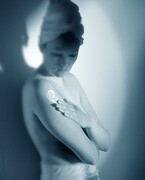- Skip Storing This Everyday Product in the Fridge Door
- Green Tea + B3 Pairing May Boost Brain Health
- Navigating Your Midlife Crisis: Embracing New Possibilities
- City Raccoons Showing Signs of Domestication
- Mapping the Exposome: Science Broadens Focus to Environmental Disease Triggers
- One Week Less on Social Media Linked to Better Mental Health
- Your Brain Changes in Stages as You Age, Study Finds
- Some Suicide Victims Show No Typical Warning Signs, Study Finds
- ByHeart Formula Faces Lawsuits After Babies Sickened With Botulism
- Switch to Vegan Diet Could Cut Your Greenhouse Gas Emissions in Half
Moles May Be Harbinger of Higher Breast Cancer Risk


The number of moles a woman has on her skin may hint at her risk of developing breast cancer, new research suggests.
In two separate studies, American and French scientists found that the more moles a woman had, the greater her average risk of breast cancer. In one study, women with 15 or more moles on a single arm were 35 percent more likely to develop breast cancer than women with no moles.
While the connection between moles and breast cancer is not obvious, experts pointed to one plausible explanation: estrogen.
The hormone is known to feed the growth and spread of many breast tumors. And there is also some evidence it influences mole growth; moles tend to get larger and darken during pregnancy, for instance.
“They could be a marker of lifetime exposure to estrogen,” said Barbara Fuhrman, an assistant professor at the University of Arkansas for Medical Sciences in Little Rock.
But that’s speculation for now. And there could be other underlying reasons for the association — even some kind of genetic factor, said Fuhrman, who wrote an editorial published June 10 with the studies in the online journal PLOS Medicine.
Her advice to women with numerous moles on their skin: “Don’t panic. This is very interesting biologically, but it probably doesn’t tell us a lot about an individual woman’s risk of breast cancer. It probably tells us more about the general etiology [causes] of breast cancer.”
A cancer expert who was not involved in the research agreed. “It’s an interesting study. I’ve never seen this association before,” said Dr. Subhakar Mutyala, associate director of the Baylor Scott & White Cancer Institute in Temple, Texas.
However, Mutyala said, “a lot more research” is needed before the findings could be used in routine practice.
There’s no proof, he stressed, that women with a lot of moles should start breast cancer screening earlier or have it more often.
“It’s not clear how this would fit into current screening recommendations,” Mutyala said.
In one of the studies, researchers led by Jiali Han, of the Indiana University Simon Cancer Center in Indianapolis, looked at data on more than 74,000 female nurses in the United States.
The women were part of a long-term research project known as the Nurses’ Health Study. Back in 1986 — when the women were 40 to 65 years old — they were asked to count the number of moles on their left arm.
Over the next 24 years, almost 5,500 women were diagnosed with breast cancer. And the odds, Han’s team found, inched up with the number of moles the women had.
Among women with none, 8.5 percent developed breast cancer; that rate was 11.4 percent among women with 15 or more moles. Women with one to 14 moles fell in between, with almost 10 percent developing breast cancer.
Han’s team considered a range of other factors — including women’s ages, lifestyle habits, weight, skin tone and sun exposure. (People with fair skin that sunburns easily typically have more moles.)
Even then, women with the most moles were 35 percent more likely to develop breast cancer than those with none.
The findings were similar in the second study, which followed nearly 90,000 French women aged 40 to 65. There was one key difference, though: Moles were linked to an increased risk only among women who developed breast cancer before menopause.
The reasons are not clear. But like Fuhrman, the researchers suggested hormones or genes could be involved.
In the American study, Han’s team went a step further to try to tease out an explanation: They looked at hormone levels in a subgroup of postmenopausal women who’d given blood samples in the early years of the project.
And they found that, in fact, women with more moles tended to have higher levels of both estrogen and testosterone. What’s more, the higher estrogen levels seemed to partly explain the connection between moles and breast cancer risk.
Still, while that “35 percent higher” risk sounds substantial, Fuhrman stressed that in statistical terms, the association was “weak.” So, in real life, moles are likely to be a minor factor in any one woman’s breast cancer risk.
Doctors already use so-called “risk models” to estimate whether a woman faces increased odds of breast cancer. Those models consider factors like family history of the cancer, and a woman’s age at her first menstrual period — a marker of lifetime estrogen exposure.
It’s not clear, Fuhrman said, what a mole count would add to that.
More information
The U.S. National Cancer Institute has more on breast cancer risk factors.
Source: HealthDay
Copyright © 2025 HealthDay. All rights reserved.










